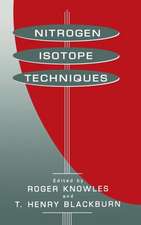Organic Structure Determination Using 2-D NMR Spectroscopy: A Problem-Based Approach
Autor Jeffrey H. Simpsonen Limba Engleză Paperback – 14 feb 2012
The book begins with a discussion of the NMR technique, while subsequent chapters cover instrumental considerations; data collection, processing, and plotting; chemical shifts; symmetry and topicity; through-bond effects; and through-space effects. The book also covers molecular dynamics; strategies for assigning resonances to atoms within a molecule; strategies for elucidating unknown molecular structures; simple and complex assignment problems; and simple and complex unknown problems. Each chapter includes problems that will enable readers to test their understanding of the material discussed. The book contains 30 known and 30 unknown structure determination problems. It also features a supporting website from which instructors can download the structures of the unknowns in selected chapters, digital versions of all figures, and raw data sets for processing.
This book will stand as a single source to which instructors and students can go to obtain a comprehensive compendium of NMR problems of varying difficulty.
- Presents strategies for assigning resonances to known structures and for deducing structures of unknown organic molecules based on their NMR spectra
- Contains 30 known and 30 unknown structure determination problems
- Features a supporting website from which instructors can download the structures of the unknowns in selected chapters, digital versions of all figures, and raw data sets for processing
Preț: 321.85 lei
Preț vechi: 469.74 lei
-31% Nou
Puncte Express: 483
Preț estimativ în valută:
61.59€ • 65.86$ • 51.35£
61.59€ • 65.86$ • 51.35£
Carte tipărită la comandă
Livrare economică 11-25 aprilie
Preluare comenzi: 021 569.72.76
Specificații
ISBN-13: 9780123849700
ISBN-10: 0123849705
Pagini: 540
Ilustrații: 1
Dimensiuni: 191 x 235 x 33 mm
Greutate: 1.18 kg
Ediția:2nd edition.
Editura: ELSEVIER SCIENCE
ISBN-10: 0123849705
Pagini: 540
Ilustrații: 1
Dimensiuni: 191 x 235 x 33 mm
Greutate: 1.18 kg
Ediția:2nd edition.
Editura: ELSEVIER SCIENCE
Public țintă
This is a primary text for a course in NMR techniques, with the goal to learn to identify organic molecular structure.Cuprins
PART I: Background and Methods1. Introduction2. Instrumental Considerations3. Data Collection, Processing, and Plotting4. 1H and 13C Chemical Shifts5. Symmetry and Topicity6. Through-Bond Effects: Spin-Spin (J) Coupling7. Through-Space Effects: the Nuclear Overhauser Effect (NOE)8. Molecular Dynamics9. Strategies for Assigning Molecules10. Strategies for Elucidating Unknown Molecular Structures
PART II: Problems11. Simple Assignment Problems12. Complex Assignment Problems13. Simple Unknown Problems14. Complex Unknown Problems15. NMR Resonance Assignment Problems16. NMR Unknown Problems
PART II: Problems11. Simple Assignment Problems12. Complex Assignment Problems13. Simple Unknown Problems14. Complex Unknown Problems15. NMR Resonance Assignment Problems16. NMR Unknown Problems
Recenzii
"I like [the book] a lot. Books that cover theory in depth AND lots of problems are (surprisingly) rare." --Steven M. Graham, St. John's University "The abundance of problems and highly detailed glossary are especially noteworthy; the quality of the spectrum presentations is excellent [...] Overall organization works well, and the layout and other 'production values' are what one has long come to expect from [Academic Press]." --Barry Shapiro
"When trying to explain two-dimensional nuclear magnetic resonance (NMR) spectroscopy, one may strive to avoid two pitfalls: getting bogged down in the mathematics behind the technique, or skipping the mathematics altogether and by default making the technique a "magic box." In his book, Simpson (MIT) has nearly done the impossible, covering two-dimensional NMR without slipping into either of those problems. Starting off with the instrumental setups and working through topics such as pulse sequences and spectral interpretation, this book gives readers all that they will need to prepare, run, and interpret a 2-D NMR experiment. This work would be useful for anyone who is currently using 2-D NMR and is a must for newcomers to the technique. Simpson provides almost 100 spectra to interpret as exercises, which make this volume an ideal teaching tool for 2-D NMR spectroscopy. Summing Up: Essential. Upper-division undergraduate through professional collections." -- S. S. Mason, Mount Union College writing CHOICE April 2009
"This book achieves what it sets out in its title. It is a balanced text covering both theoretical and practical aspects of NMR spectroscopy. The first seven chapters give a comprehensive discussion of the relevant theories and practical considerations in the use of NMR spectroscopy for organic structure determination. The later chapters delve into strategies for organic structure determination and provide complex and simple assignment and identification problems, representing the most common applications of 2D NMR… I found this book to be very well written and accessible." --Chemistry World
"When trying to explain two-dimensional nuclear magnetic resonance (NMR) spectroscopy, one may strive to avoid two pitfalls: getting bogged down in the mathematics behind the technique, or skipping the mathematics altogether and by default making the technique a "magic box." In his book, Simpson (MIT) has nearly done the impossible, covering two-dimensional NMR without slipping into either of those problems. Starting off with the instrumental setups and working through topics such as pulse sequences and spectral interpretation, this book gives readers all that they will need to prepare, run, and interpret a 2-D NMR experiment. This work would be useful for anyone who is currently using 2-D NMR and is a must for newcomers to the technique. Simpson provides almost 100 spectra to interpret as exercises, which make this volume an ideal teaching tool for 2-D NMR spectroscopy. Summing Up: Essential. Upper-division undergraduate through professional collections." -- S. S. Mason, Mount Union College writing CHOICE April 2009
"This book achieves what it sets out in its title. It is a balanced text covering both theoretical and practical aspects of NMR spectroscopy. The first seven chapters give a comprehensive discussion of the relevant theories and practical considerations in the use of NMR spectroscopy for organic structure determination. The later chapters delve into strategies for organic structure determination and provide complex and simple assignment and identification problems, representing the most common applications of 2D NMR… I found this book to be very well written and accessible." --Chemistry World

















